Is Digital Manufacturing a Friend or a Foe?
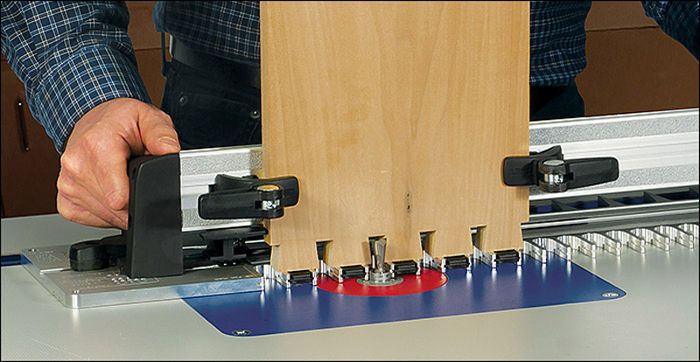
The dovetail jig makes a difficult process quick and easy.
We are at a pivotal time in furnituremaking history, where fewer people than ever know how to build things by hand but new technologies can turn out one-off pieces days faster than the most skilled craftsman, and in fact, produce forms not possible by any other means. Is this a threat to all things handmade–to our concept of perfect imperfection–or are the CNC and 3-D printers just exciting new tools? Longtime studio furniture maker Scott Grove, who has run everything from a large-scale operation to a one-man shop, was nice enough to share the thought-provoking discussion that he presents at schools around the country. No one has all the answers, but Grove asks all the right questions.
-Asa Christiana
Fine Woodworking
“Ever since I started woodworking I have always wondered: Is using technology comprising my craftsmanship? I would buy a new tool, the latest and greatest gizmo that would give me a better cut, quicker and more accurately, and then a friend would jokingly say, well, that’s just cheating.
So the age-old question is: Does technology take away from true craftsmanship?In recent years this has become more and more of an issue or dilemma as advanced technology is becoming more accessible. With the use of CNC machinery, wood can now be cut, carved and shaped more accurately and quickly than one could hope to imaging. As a business man, I embrace this efficiency but sometimes wonder if I am losing touch of my craftsmanship. Am I still a maker? Or now redefined as a designer and assembler?
Why do we seek more advanced technology to create? Certainly the bottom line is an easy answer but isn’t it also to reach perfection? As a hands-on craftsman, I strive for it, to make the perfect joint, seam, cut curve, carved pattern and finish. That new piece of equipment that cuts cleaner, faster and more accurately will always to be selling point. In Western society, we dwell on imperfection as a flaw and often consider it a failure or subpar, shoddy craftsmanship. Certainly the world of craft is starting to have a negative connotation. Poorly handmade. Are we missing the fact and appreciation that these flaws might be a human touch? OR do we and society want perfection do matter how it is achieved? We are now at a stage in the game where furniture can be completely designed and created with the push of a button. Some will argue that the design and even the manufacture is still a craft, but is it? Really?
When I started to deliberate this question, I began by breaking it all down. What is technology, and what is craftsmanship? Technology means using advanced machinery and knowledge often associated with science and math. Craftsmanship means creating by hand, actually touching the material. Sounds easy enough, but where is the line between the two? How advanced can the process be before the piece is no longer handmade?
Looking back there has always been advanced machinery, from chisels made from bone, to steel saws powered by water, then electric tools, and so on, each advancement allowing us to work a little more efficiently. However, in most cases we still directly controlled the tool and the material with our hands. For me this is an important distinction. With hands-on control, I have the option to spontaneously react to the material and the tools performance, change in midstream, go with flow, this relationship I have is intrinsically intimate. Machines simply can’t do this.
On the other hand, I see many “craftsmen,” myself included, using advanced technology to produce furniture–laser-cutting veneer, using CNC lathes to turn precise duplicates and mill high-tolerance joinery–and these furniture makers are considered some of our best. Are they the best craftsmen? Or, are we now seeing a divide between true hands-on craftsman and now, designers?
So a question is IF one is able to cut a perfect dovetail, then is using a machine to do it OK? Possibly a bigger question: Is machine-quality better the handmade quality? Do the patrons care? Does the public appreciate handmade work? Are they losing touch with it?
What is more valuable (and/or satisfying), a perfectly hand cut mortise joint or a perfectly machined one? A symmetrically handcarved texture or a similar one created by a machine?
More than ever it seems to me that true craftsmen are responsible for educating the client on how pieces are made. But how much hands-on is handmade anyhow? I can have a machine spit out all my parts and I simply glue them together with some hand sanding and a little futzing, say 10% handwork. Handmade?
Another issue is how much does a master craftsman have to touch the wood as opposed to an assistant? It is common practice to have apprentices, interns and employees assist or completely make a piece under the supervision and title of the notable craftsman, who adds his signature with final inspection. Still all is relatively handmade and acceptable. What about items that are handmade by children in a grass hut on the other side of the world? Certainly handmade. Which is “better,” to use advanced machinery or third world labor? I am in awe and also sympathetic of these third world craftsmen which I have personally witnessed. They obtain an amazing level of craftsmanship with a minimal use of technology, and are in horrible working conditions. This opens up another Pandora’s box, which only an individual can resolve within themselves when purchasing these items.
Are we at a crossroads dividing designer/maker/craftsmen from designers /engineer/ assemblers? Do we need a new certification defining such hands-on craftsmanship, similar to FSC (Forest Stewardship Council) providing the terms or parameters of handmade and the use of technology? How about ‘CLAH – cut by laser, assembled by hand’?
Obviously there are more questions than clear answers here. But one thing is for sure: Technology is here to stay and will keep advancing, becoming faster, more accurate, cheaper and easier to use. The technological craftsman is a reality and our trade is splintering in two.
The dilemma is how to use technology without losing touch with our craftsmanship. Or is that just cheating?
–Scott Grove, ScottGrove.com

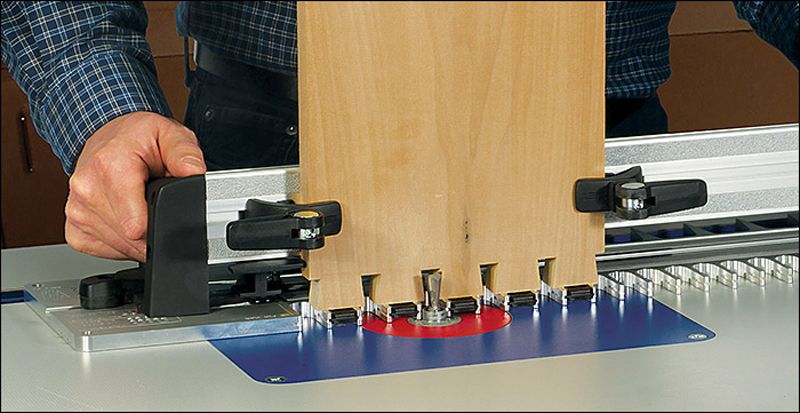
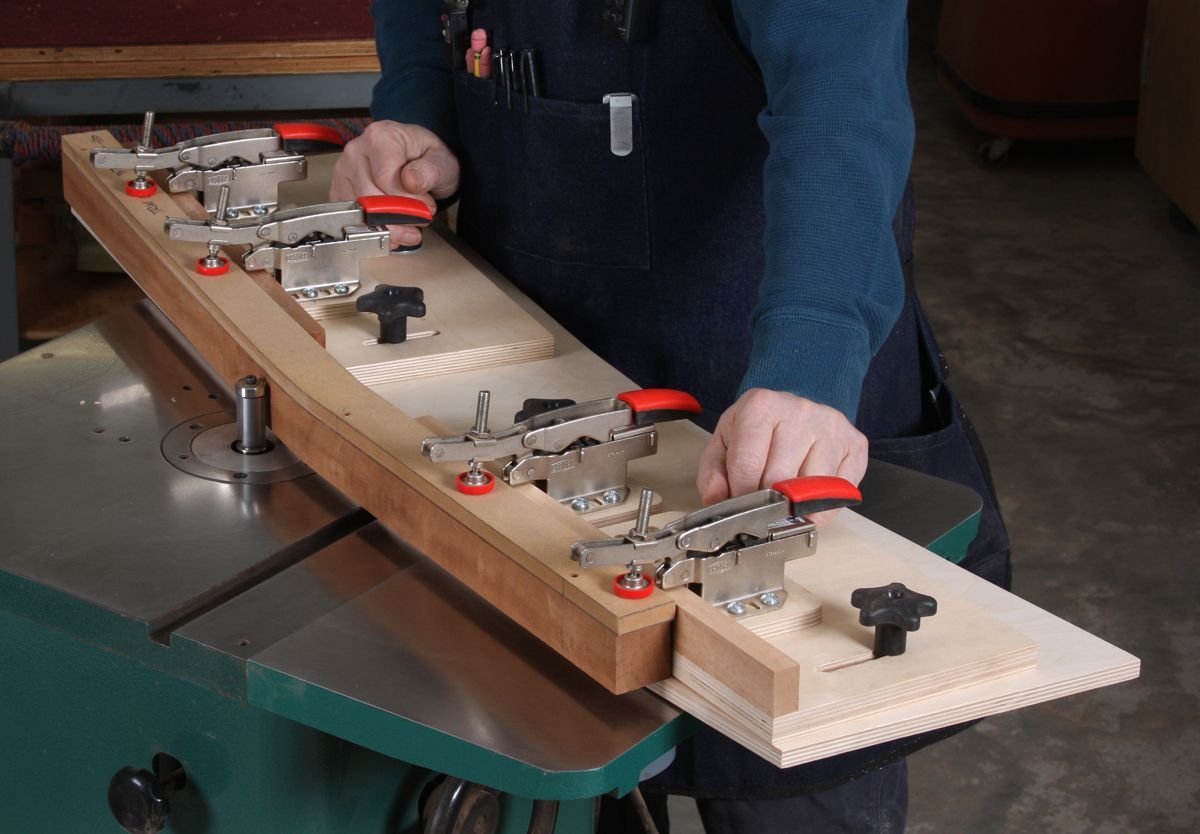
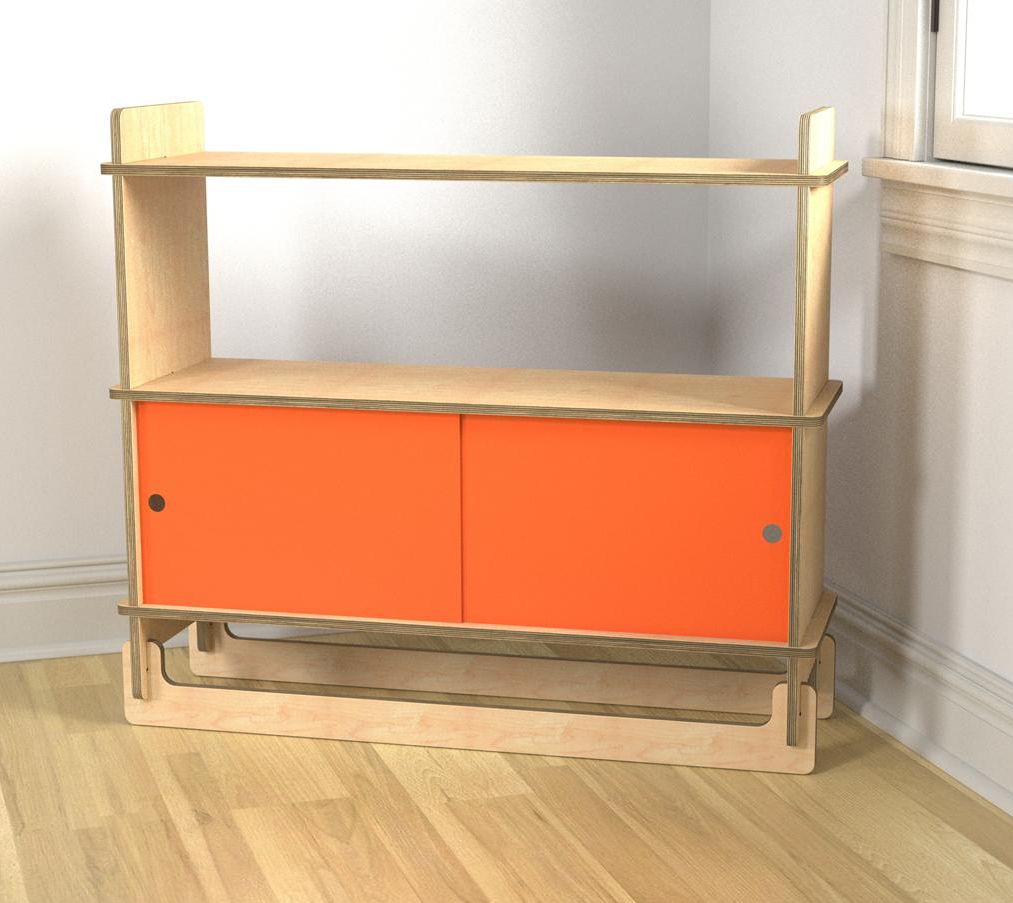
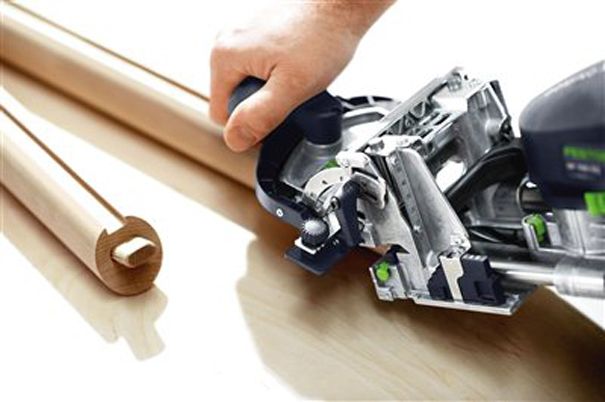

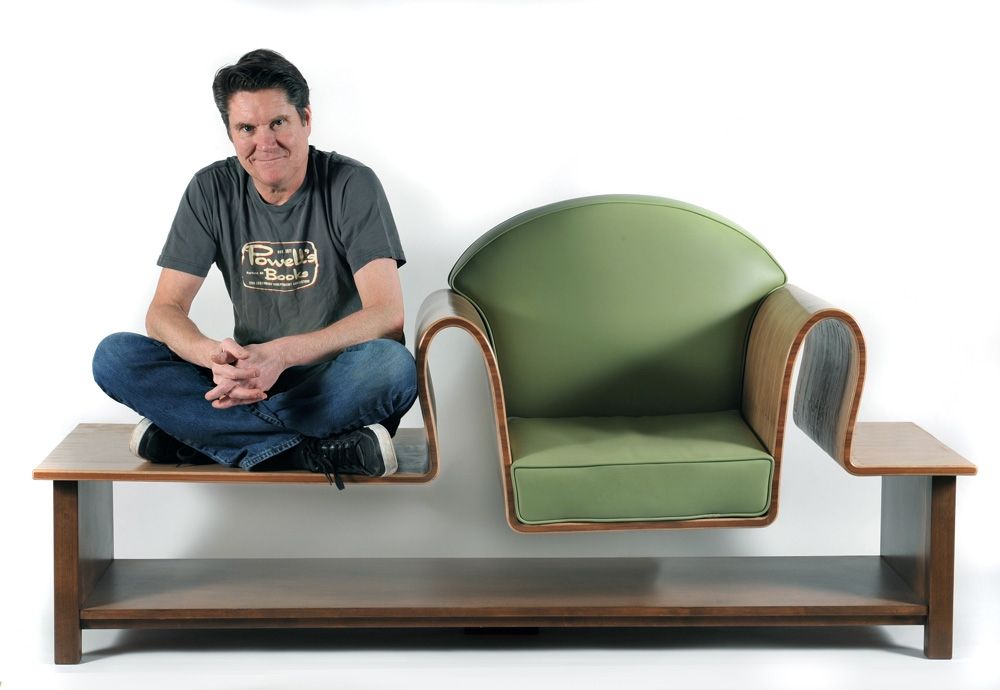

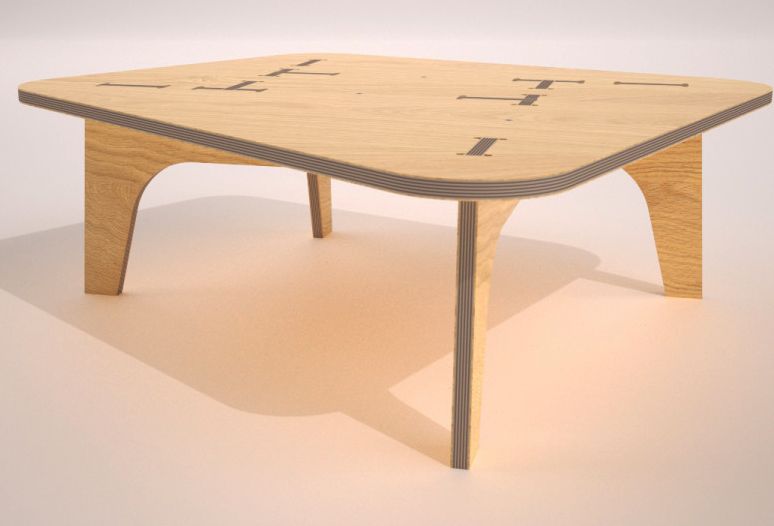
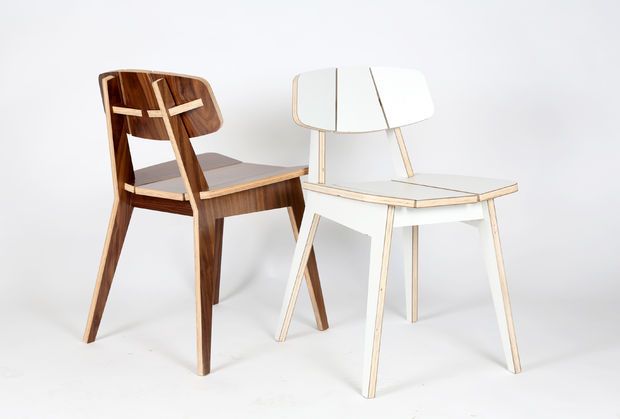
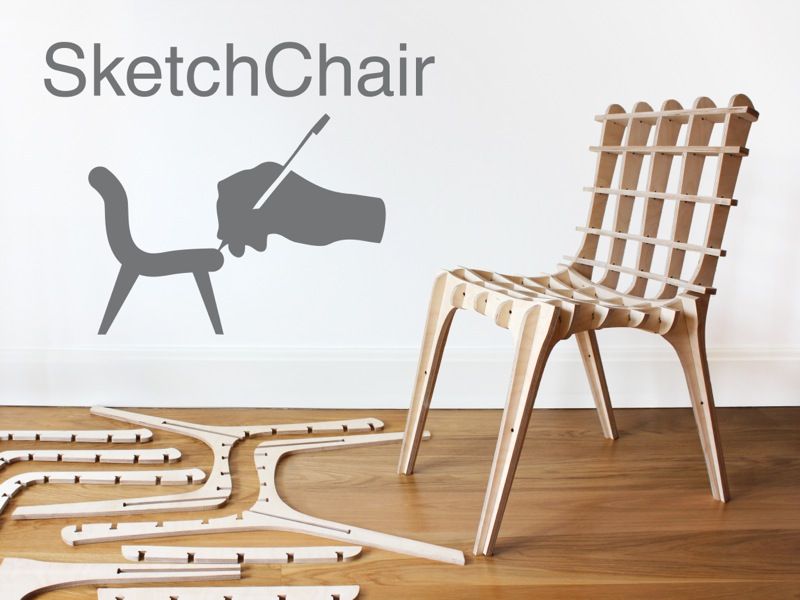



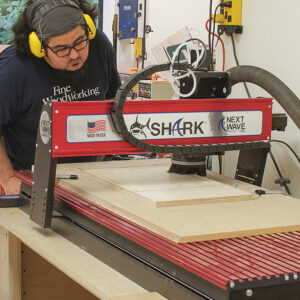
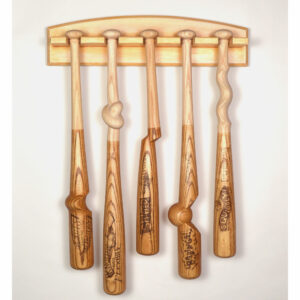
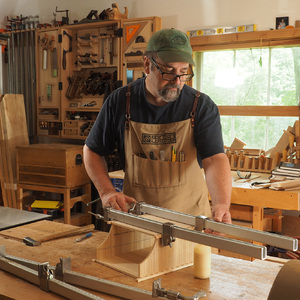












Comments
Thanks Asa for the thought provoking essay.
From my own perspective, I enjoy making things with my own hands. At times I choose a machine to assist me in making a cut---a bandsaw, a router, a sander, etc. But since I am making something for myself, my choices are dependent upon how much time and effort I wish to spend and/or whether or not I wish to learn or a new skill. I have neither the money nor the desire to buy a digital/computer driven technology to woodwork as the experience would be less pleasurable but I have the luxury of woodworking as a hobby and work.
When the tools are driven by myself or the wood is pushed through by myself so I consider it handcrafted all the same, but I take more pride in a part when I use a hand tool rather than a motored one. I typically use the same metric when buying an object putting a larger premium on the proximity of the craftsman to the material whether it by pottery, art, woodwork, etc.
The premium I place on a handcrafted piece comes not from the perfection (they often aren't), but the effort, difficulty, and skill to do so. One can put their soul into a piece by being so close to the object itself. While one may put their soul into a design when crafted purely by machine, it is really the design and not the physical object itself that then carries value. And at times that is desirable as well, but in those cases I look for something that is unique, novel, and impressive.
It's all good... CNC devices and 3D printers will interest some "makers" who otherwise might be playing video games or working recreational spreadsheets... just getting them into the physical world is a good thing. Having spent too many years in front of/serving electronic devices, I am happy to pick up a hand plane and enjoy the pleasure of slow "making." Now, if I had to support a young family as a woodworker I would want to follow a path with some chance of economic success...whatever the combination of tools and high/low art.
Great comments. All the credit goes to longtime furnituremaker Scott Grove (ScottGrove.com), who wrote the essay.
You can take a look at the sport of archery to see where this all leads. Up until the 1940's, all bows were made by hand, carved wooden bows made with drawknife, spokeshave, etc. Then bowyers discovered fiberglass. While there were previously some laminated wooden bows, now all bows were made of laminations glued under pressure and heat on a form. Then came the compound bow. At first they have wooden/fiberglass laminated limbs, then later just molded fiberglass. Bows were now constructed by machines and metal lathes. Compounds kept evolving and were no longer made of wood at all. Then many states legalized the crossbow for hunting and now most "archers" don't bother with the compound because it still required practice. Now you can buy an arrow-gun crossbow with scope, practice for 10 minutes a year, and go out hunting. This is where the mindset of faster and easier will take you. Archery was nearly destroyed, saved only by a few stubborn purists who persist in using wood and even making there own. This is where woodworking will arrive in time. The old cranks who stick with hand making everything will be the purists. Many will fall somewhere in between, using both hand tools and machines. Each person will pick his/her level of satisfaction. If you are in it for the money, you will invest big dollars in the computers and CNC machines. But that's not woodworking, even if they do use tree parts. These people are simply making money, they could just as easily switch and make car parts. Will woodworking mostly fade away except for the old cranks? Who knows.
This discussion probably has no real solution/conclusion. Tools will always advance. Someday CNC/3D machines will be obsolete themselves. I doubt there are many farmers still using an Ox to pull a plow, although you can find/see them in museums. It's kind of like asking at what point did my restoration turn into a reproduction?
I teach college design students how to make furniture using CNC routers. Those that understand or learn traditional joinery make the strongest pieces. Those that understand or learn handplanes and carving make the most tactile pieces. The students who don't know or learn these skills often build sterile furniture that will not last more than a month. CNC's are awesome tools but they can only be used successfully if the maker has a foundation of other skills.
Asa, I feel that a certain amount of machinery is desirable, but when the machine functions unguided, then the piece is not handmade. I would not like to be the man in the saw pit cutting lumber, but I do want to choose smooth and joint my material. I want to use router or saw to cut joints, but want to hand fit. I want that tactile experience of carving a detail, or seeing a hand/machine cut mortise and tenon joint fit like it grew there. This is what I need to feel when I hand/machine build a project. I cannot get this when the only input is placing the the material in the machine. Call me old fashion, but I am old and fashion never goes out of style.
A few years ago the same question was asked. My answer is still the same.
Someone earlier said it's not cheating until you start using a CNC. Have you ever used a CNC? You still need the skill of an architect to draw the piece. You need to know how to set up the correct cutter. How to read the grain of the piece you are machining etc.
Is using a marking-gage from the 1800's cheating or do you mark everything freehand with a pencil.
When I look at a turned leg, I don't wonder if it was made with a pole lathe or a power lathe. I just admire the fine design and looks of the piece.
I don't care if you made a dovetail with a machine or by primitive hand tools, I just care about the end results.
What a bunch of SNOBS on this site. (Not everyone).
Just enjoy working with wood, it is FUN and should be simple.
posted: 9:47 am on January 12th
Now, would you want a doctor to cheat and use MRI's or just look at your eyes to tell if you have cancer?
What is your purpose? What is the value of your purpose, first to you and then to others (your clients)?
As your life changes, so will your answer to these questions. An interesting article might be one where these 'compromises over time' are with successful woodworkers and designers like Chris Becksvoort, David Marks, Curtis Buchanan and even Peter Follensbee. I believe that Mr. Follensbee, the quintessential worker of wood using tools without a tail, has used a powered sharpening wetstone for his carving tools at times (please correct me if I am wrong.)
Anyway, unlike others above, I think there is an 'answer', but it s personal, not industry-wide. How we adapt is always our biggest battle. Our work is an expression of our personal values. Sometimes that value is to just give the market what it wants the best way you know how.
What is your purpose? What is the value of your purpose, first to you and then to others (your clients)?
As your life changes, so will your answer to these questions. An interesting article might be one where these 'compromises over time' are with successful woodworkers and designers like Chris Becksvoort, David Marks, Curtis Buchanan and even Peter Follensbee. I believe that Mr. Follensbee, the quintessential worker of wood using tools without a tail, has used a powered sharpening wetstone for his carving tools at times (please correct me if I am wrong.)
Anyway, unlike others above, I think there is an 'answer', but it s personal, not industry-wide. How we adapt is always our biggest battle. Our work is an expression of our personal values. Sometimes that value is to just give the market what it wants the best way you know how.
In some corner of my mind I have been considering this is issue. I think the nature or environment of the processes makes a significant difference as to how and why a finished product appears. I have seen several examples of both large and small products produced by sophisticated machines. In an essentially business sense efficiency must be paramount. Whether the process is controlled by the technology or the designer is not critical. Perhaps the quality of the completed piece is most important.
Someone has said that "Machines can do the work of many ordinary men, but no machine can do the work of one extraordinary man". Technology is at least beginning to render that opinion obsolete and from my perspective it is a bit sad. A "techie" designer can produce great work without lifting a finger beyond moving a mouse or pressing a button, A craftsman can make by hand something a designer draws. But the ability to envision a design and then transfer that vision to something beautiful and useful is what makes the work extraordinary.
I am a retired "educator" and Athletic Trainer and much of my job required hands-on work. My woodworking is more of a hobby but gives me "something to do with my hands". All of my pieces are small and relatively unique. I have a collection of machines with which to do some of the "grunt work" but the enjoyment of woodworking for me involves getting my hands on the materials, the final shaping, fitting and finishing and the tactile and aesthetic quality of a piece. I most enjoy finding a discarded piece of wood with interesting figure and color and building around what I see, But the fact is that if I had to make a living in this environment I would starve to death.
This discussion will likely never arrive at a point of total agreement but it is not a waste or time and thought. At the end of a work day we still get to clean up a pile of carefully made chips and saw dust!!
Are there still proofreaders at FW?
a very interesting and thought provoking blog post. it is a subject that has been kicked around our modern cnc equipped shop here for the last 10 years. i personally have come to the conclusion that the distinction between hand/machine made is a useless provocation .. i think the main point of making anything is the process itself and the results of that process. how we got there is a personal choice, and the results and our pleasure in the process are the defining criteria of success. often i feel the defenders of 'handmade' have not actually experienced the complexity and rewards of using technology to do things that would be more or less impossible to do by hand with normally acquired hand skills. sure, there may be someone somewhere who can do by hand what your are doing with technology, but are you personally gonna be that person? likely not. and what's the point? it takes a really long time to get really good at something. fire up the table saw and you leave the world of 'hand made' in my humble opinion. i think the shakers invented the planer and the table saw and i bet they would be lined up 3 deep at the cnc booths at the woodworking shows if they were still here making their 'handcrafted' furniture. after 35 years of professional high end furniture making, i would say unequivocally that while we made some good stuff 'by hand', most of our 'best' pieces have been made using the marriage and magic of cad and cam, and our pieces still have a 'handmade' look. in fact, one of our shop goals is not to 'perfectly execute' a piece, which can sometimes be the result of 'flawlessly executed' hand work. wabi sabi, please. and that's just our furniture. our son sam uses the cnc for forms and jigs that without it would make his architectural metal work more tedious, complex, less fun, and quite a bit more expensive to boot. and now the other son, will, (seedersinstruments.com) is using the cnc with router bits that measure .015, less than half of a 32nd of an inch, to do stuff i would never have imagined, with accuracy and efficiency that i don't believe many folks anywhere could do by hand. he's now working out the 3d stuff and has rough carved both guitar and banjo necks with our 3 axis multicam. go figure .. if you want it to be, technology is your friend. if you don't want it to be fine, but please keep an open mind, and let's do away with the 'cheating' comments. what are we cheating at?
Until a CNC machine can read and apply "The Soul of a Tree" by Nakashima or design like Krenov or Maloof, craftsmanship will never be obsolete.
I have read that it was not unusual for the early master artist/painters whose artistry was in demand, to set up "mass production" studios.The way it worked, the master would block out the canvas, set the design, choose the colors and an apprentice would paint the basic piece. The master would guide this process for as many apprentices as were working. Then the master would take over, add the final details--the artistry--and sign the piece as his own. Dozens, perhaps hundreds, of these works of art hang in the great museums of the world. Were they cheating? Are the works fake? The art world long ago decided they are genuine. I see a parallel here in the question at hand, and some of the comments touch on it. Where does the artistry of woodworking begin? Felling the tree? Sawing the log? Or at the final stages of shaping, fitting and finishing? I'm no artist and I lack the necessary skills sometimes. I use machines to do what I can't do or don't want to do. But I take pride in the finished product and don't highlight the flaws in my work. On my admittedly subterranean skill level how is that different than the master painters?
My dear fellow woodworkers (the ones who really are), greetings !
First of all, my apologies for my awful English. As a brazilian and native in Portuguese (not Spanish !), I do not have the complete domain of your language, but even so I dare trying to express my ideas. Sorry for that.
Since it's almost impossible to produce something from wood using bare hands and teeth, let's suppose that tools are considered acceptable, for the purpose of this discussion. If that's the case, from this point on, in my opinion, we could first divide the activity of producing something from wood into two groups:
- according to the source of power (man or electricity);
- according to the source of the control (man controlled, or computer controlled).
As someone who works everyday trying to become a woodworker, my model of perfection would be someone who knows everything about wood and woodworking. This knowledge would make her/him able to harvest her/his lumber, dry it, mill it using hand tools, glue the parts and apply finish, and producing wonderful furniture.
I know some (rare) guys in Brazil that are able to do that (they're even able to produce their hide glue), but all of them are dying - due to the age, not due to their knowledge .... Some of them love the craft, and some of them make their living from it. They are woodworkers, even when they use electrical tools.
Once, I took classes with Adrian Ferrazzutti. He told me that if he has lumber and a scraper, he would be able to build a shopping mall. That's, in my opinion, a woodworker, someone able to produce handmade furniture (even with electrical tools).
Take a real woodworker, with good taste in terms of design, and give her/him lumber, CAD and CNC machines. She/he will produce wonderful furniture. If you give her/him a set of hand tools, it will take longer, but the result will appear.
Now, take a computer jockey, give her/him lumber, CAD and CNC machines, and pull the plug from the electric outlet. Give her/him hand tools. The result will be zero.
Tools are useless without knowledge. Knowledge precedes the tools.
If the discussion is about making money, I totally agree with Brad Benner. No doubts computer controlled devices are able to produce faster, with lower costs and, usually, with higher quality. But it's only making money, not being a woodworker.
If the question is the fastest way of making money, there are better ways - by far - than being a woodworker (a real one, or not...)
My best regards,
Fernando Belchior
I tend to separate the concept of Manufacturing from the Craftsman. Craftsmanship is just one of many aspects to look at. But to Scott's question of using technology without losing craftsmanship, I think it is possible but the "craft" is different in this case.
When I look at the examples of the CNC furniture you have posted it's all about the end result: really interesting, exciting and mostly NEW DESIGNS. But this is true for handwork as well whether it's new, traditional or old styles. It's the concept/idea AND execution that make an item stand out. CNC technology gives us the ability to execute ideas that would be difficult or impossible to do with traditional methods (even with table saw bandsaw etc.). Personally for me, how the "making" was achieved is less relevant than the item's own merits: I.E. visually pleasing, well engineered, having a good finish, interesting design, solves a problem etc. In other words all the same criteria that we judge furniture now by. I don't think the term "cheating" is appropriate in this process. To make good work, skill and mastering your craft is needed whether by hand and/or machine. Love seeing good work from ALL processes!.
I question those who say our quest is perfection in the areas of cuts and joints. Good knock down big box store furniture has perfect fitting butt joints dependent on fasteners, the surfaces are often so perfect they look artificial to those who know . . .
One of the important aspects is honesty/authenticity. This is something I also see regularly in the area of digital imaging compared to analog photography - if an photo I've taken is called into question there is a negative, if its a digital image you need to prove its not a fake, when programs can help simulate analog characteristics of lens and film.
The same can be said into the question of when is something crafted by a person vs. manufactured. This has occurred even with our other tools - dovetail jigs, inexpensive ones show they're artificial the expensive ones can be fudged. . .
Isn't one of the signs of a good craftsman is not in the absolute perfection of the spindles but in the fact that a person can't notice the difference. As an earlier commenter said yes if you don't have the skills it will look sterile - I worry how long until there's an app for that. Look how often our society shows in commercials and such shots of people faking something.
I hold out hope that we can weather the storm and ride it out through education, not letting the technology drive our art as that technology fills the pockets of those who don't care or are ignorant.
There is hope for honesty and authenticity just look at the re-emergence of vinyl.
The answer here is very very easy...Using a computer and CNC is not fine woodworking.Nothing to defend!!
I have this discussion often w/ friends that run a shop based on CNC. They don't claim to be woodworkers but are by no means just assemblers either.
When they started, they worked entirely in plywood and really just assembled pieces. Over time they've moved into more complex pieces incorporating hardwoods and traditional joinery (still CNC cut). Once they started creating more complex pieces, they began to make a distinction between their earlier work (assembly) and their more recent work, which they view as fabrication.
I think fabricator vs. woodworker is a good distinction. They don't claim to know how to hand build fine furniture, but they really turn out some beautiful pieces. I often wish I had more access to their tool.
My personal view is if a CNC is used as a tool in part of the process, then it can still be viewed as woodworking. If a piece is entirely cut out by CNC and assembled, then it's fabrication.
Just a friendly observation. The article and topic is great, but it would be helpful to proofread it before posting. Way too many grammar mistakes in this one.
I do not make my living working wood so I am fortunate enough to take as little or long as I want on a project. I love the process of working with my hands and with tools whether by hand or power. If I started drawing things on a computer, cutting them out by CNC,and then assembling them I might as well find a new hobby. There are some beautiful things being made from the high tech industry and that's just fine with me. Those are the people who are making a living designing and building furniture.
I love the feel of a sharp chisel or hand plane cutting wood so I won't be changing the way I do things any time soon. If I were to buy a high end piece of furniture I would probably go to furniture maker who works with their hands because I like the imperfections that make something"hand made". I think there is room for both in the furniture world.
the one question that I have to ask first is; it it economical to make one off furniture by having all this wonderful cnc machinery. I can understand this even in a one man production shop, building for the masses.
is it all about money
ron
Ah, CNC rears its (ugly?) head in the world of woodworking!
As a machinist, who started at age fifteen on a small manual lathe, I've had to learn to set-up and run not just manual machines but automatics and also program CNC equipment.
The question of craftsmanship should pertain to who designed the product and who conceived the process for producing it. Some products are poorly or impractically engineered, but made by superb methods; some studio pieces are only art and useless in a home. Other products are well thought out but made by hacks and require TLC; cheap Asian copies of machinery are examples.
First half of craftsmanship must come from the designer's mind. He or she should know what sizes, materials, joinery, finishes to employ to make furniture.
Second half of craftsmanship rests with the executor(s), who select methods, equipment and tooling; and make the first piece. Any jigs and fixtures are also planned and made. Whether robots or unskilled laborers move the material about is irrelevant.
Personally, if I had the financial resources and the workshop space I would love to own a CNC, but not to do all of my work for me. When I began woodworking it was all about getting the project done as quickly and efficiently as possible. If it took longer than a couple of hours to do I considered it to be something major. As I've grown older, I have learned that the journey is at least as important as the destination. I enjoy spending time on a project, working out every last detail, figuring out how to translate what is in my head into an object that didn't exist before I created it, something made of a living medium like wood.
I have a shop full of tools from a bandsaw to a table saw. I also have hand saws which I also employ. I have a planer, but also use hand planes. I have a drill diver, but also use and sometimes prefer a hand held screwdriver. I enjoy the work, and enjoy using time honored woodworking methods. No doubt that if my shop was profit driven I would have any and every machine available to increase profits, but I wouldn't advertise a piece as hand made.
The distinction is pretty clear. Handmade is made by hand even if those hands are directing a machine. Machine made is hands off. The machine does everything but the glue up.
Having retired early after 35 years of research in the hard sciences, I am returning to my first love - woodworking. I was taught in the UK by skilled cabinet makers and at 16 had to make the choice between science and cabinet making in the traditional sense using hand tools. With that traditional background, I was reluctant to buy anything other than simple power tools like a drill and jigsaw in my 20s, but in renovating a house built in 1913 discovered that I needed more tools, even some stationary power tools. I felt considerable guilt about buying these items, even a cabinetmaker’s saw, although it helped make many bigger jobs easier. The 5 years before retirement saw me filling my workshop with stationary power tools, such as a router table as I saw the need for such machines to create different moulding profiles for fine furniture. This has produced a workshop equipped for both hand and machine based woodworking of many traditional projects.
After taking a business course in 2013, I decided that if I was going to have success making English Period furniture and toys, I needed tools that would reduce the cutting time of parts considerably. This was a big emotional choice for me. I did not want to choose the CNC direction because of the satisfaction derived from working by hand. However, I realized that while I could make 1 or 2 Chippendale or Hepplewhite style chairs for a customer wanting a 6, 8, 10, 12 chair dining set, the sheer repetitiveness of a larger task would drive me crazy! Also, in order to help with the traditional replication process, I would need to utilize templates to standardize the components for each furniture design. Given 10 different leg designs for chair, table, sideboard sets, I realized that I would soon require addition storage for the templates having used my upper workshop space for lumber storage.
Having considerable computer experience, eventually my head won over my heart, as I realized that many digital patterns could be stored on a HDD, SSD or USB memory stick (far less space required), modified after test cuts and could be readily moved across my home network from a CAD server in my house to the computers controlling my machines in the workshop. I also realized that if I could reduce the cutting time of components using CNC machinery, I would have more time with the plane, chisel, spoke shave and scraper to do the hand finishing that gave me so much pleasure. Some have suggested that cutting materials with a CNC router or laser cutter can reduce 50-100h cutting time using traditional methods to 1h. This is a clear advantage commercially in a one man operation and certainly helps with making toys (my cash cow) and using nesting programs reduces wastage. At the same time, I can be working on furniture by hand, make my own inlay/banding patterns and cut marquetry panels (I learned the knife technique as a teenager). When my UL/CSA certified 1390 Bodor laser cutter refitted by Tom Baczynski at CanCam arrived, I realized that my cabinetmaker’s saw, band saw, scroll saw, radial arm saw and router table would still be used, but less frequently than in my hobbies and DIY projects. This had me asking myself whether they were money well spent and whether given the size of my home workshop, I should not be disposing of some traditional stationary tools to make more usable space. Again, more sadness after so much thought into buying quality tools over the years.
For a start-up, one person, home business, the investment in CNC machinery is a harrowing experience (safety certification issues and liability insurance in a commercial space in Canada) and has taught me a great deal about working with Chinese manufacturers of such machinery (lately, Jinan Omni CNC Tech. Inc.). I have now spent 2 years gradually setting up this business with the belief that once everything is in place, my combined technical and traditional skills will enable me to be more productive than would have been possible using tradition woodworking methods alone. David Mannock
This article poses questions that all woodworkers should consider, since the questions have to do with the spiritual connection many of us have with this intensely personal material.
Technology will enable us to produce things more accurately and flawlessly than was ever possible. But is that our ultimate goal? If we were working with metal, perhaps. But wood is not metal.
Anyone who has fallen under the spell of this quixotic and exotic medium might answer that wood brings its own personality into every situation, along with its own demands. Wood speaks to each craftsperson in subtle and different ways. While it holds a myriad of secrets waiting to be released, different possibilities will be revealed to each woodworker.
Can anyone capture the beauty and delicacy of wood by using machines? Perhaps. But the human brain, eye and hand combine to offer a far more sensitively nuanced response to each unique piece of wood, than any computerized device that has thus far been demonstrated.
Craftsmanship divorced from vision is probably doomed. It cannot compete with the machine. But craftsmanship characterized by a respect for wood along with a creative vision transcends the need for accuracy, and seeks to ask the question, "What is this piece of wood wanting to express through me?"
Should we use technology or not? This is an important question. I would suggest that the answer lies within each individual. Is technology enabling you to accomplish your vision and to unlock the secrets held by the wood, or not? Each craftsperson must answer that question.
There is no new problem here. Consider a beautiful print versus the original oil painting. One is the proud creation of the artist and the other merely copies. One represents the creative process and 'collector' ownership, the other a utilitarian purchase. Fine woodworking is the province of the creator and the collector. The rest is for public use and consumption. The fine woodworker is a creator not a manufacturer. In my family's eyesI'm a fine woodworker and that is enough for me.
Pizzicato
Hi,
I live in Belgium, speak french and dutch but may be losing my english as i rarely practice it since a few years. So, please forgive me if I make more or less mistakes.
I work wood as a hobby and it's a nightmare for me to just consider the money i have to spend in hundreds of tools and the place i should have to use them.
Even as a hobbyist, i can't escape thinking economically. Reading on many forums that many who made their own furniture don't know if they even cover the cost of their equipment by avoiding having to pay a professional raises a question. Why not simply design (on computer), have your pieces cut (by a computerized cnc machine) and just mount the pieces (with a little sanding, gluing, clamping, finishing...).
Economically speaking, this may in many cases be the right option; even for the professional with "modern" tools.
You can't escape considering it...
Anyaway, this being considered, we may still feel uncomfortable with this movement to more and more technological approach that seems to take the tool out of our hands. The cnc being the actual flagship of that movement that began long ago and against wich the Arts & Crafts movement couldn't resist.
So, why do we feel uncomfortable with this? And, who does fell so?
I think it's our craftsman's soul. A friend of mine works as a designer -see http://www.jo-a.eu - has is soul raised by working on computers and cnc. Well, I don't.
So, i'm driven back to my handcrafter,s soul; wich i'm eager to satisfy. And guess what, i like routing (a modern tool that some may think is contrary to the use of many old-fashion planes...) but, for some pieces, i can't afford to and must go for hi-tech "out-of-my-hands" cnc.
I hear the debate and have seen it before in my first industry, printing. Prinitng made the move from from moveable type letterpress printing to photoplate offset printing stating back in the 1920's (before I was born) and the great hub-bub was that it was cheating and the quality wasn't there. As time went by the quality got better and the machinery got cheaper. The companies that adopted offset printing could do the work faster and cheaper that the people using letter press, so the consumer was unable to tell the difference and so they went with the cheaper price.
By the time I remember my dad being in the printing industry, letterpress printing was a specialty process for things that an offset press could not do, such as foil stamping and imprinting. Then in the 1960's this thing called a Xerographic copier came out and the image was terrible. Printers said that they would never use that technique and it would never catch on, but again the image got better and the machinery became cheaper and it was possible to have unskilled labor run it. Thus Copying became the way people did short run "printing".
Next in the 1980's came the advent of the personal computer and dot matrix printers (remember them?) with the lousy looking image and X's to make images. Printers said they would never be in the printing business. Again better and cheaper, they enabled people to do their own typesetting, and when the laser printer came out, big companies could print there in house memos and items fo such from their desk.
As the small laser printers became more affordable, printers used them to do their typesetting, and eventually they did their short run jobs on them. In 2000 the Y2K scare hit and small companies everywhere stop ordering printing to see if the world of business would shut down. It didn't and they realized that they could do any of the jobs in house on a PC instead of using a printer. This lead to the Printing industries entering a tailspin.
Color Lasers and Inkjets where the last straw in the demise of the printing industry. Once considered the most profitable business to be in, it is now a niche market for large runs and specialty items.
The point being that there are still some small letterpress printers out there for a specialized market of people who appreciate the craftmanship, but it is not a thriving industry.
Thus goes the woodworking trade. From all hand tools, to water driven power tools, to electric power tools, to CNC tools. Is there still a market for handcrafted items? Yes, but the masses probably can't afford them and they would still like to have them. So the industry supplies them with CNC cut products which reduce waste and speed up production, and on the low end cheap particle board furniture with plastic "tape" printed to look like wood, and the masses buy it in huge quantities.
So my conclusion is this, instead of debating whether is is cheating or not why not embrace the method that you choose and market it as such to those who appreciate it and realize that there is a market for all of the manufacturing methods.
Grove arrived with the questions that we all were very much afraid to ask. But I guess this matter had to come to serious public discussion after all, and nobody better than him, a very accomplished craftsman, to spell then.
A parallel to this quest could be made to several fields of work, from electronics to physics, to cooking.
I may have a different view from some of the other woodworkers, including my fellow citizen in this forum.
When I saw that Marc Adams was giving courses using CNC and laser machines, my first though was: what is going on with woodworking, why is this fantastic artisan using automated equipment? But then I remembered his statement in the first class I took with him (quote is approximate): “You may see me telling you to do things differently than everybody else, and not how you learned, but it is my belief that we should use the method that will arrive at the job done, the quickest and most practical way.”
Well, I guess we all begun to appreciate now that these automated systems are here to stay, and that woodworking will change forever. More advanced machines will be created. Everyone will begin adopting them, and smaller and smaller shops will get them, as prices spontaneously fall.
Is this the end of hand tools, traditional methods and all? Let’s face it, one day nobody will bother sharpening chisels and plane irons, cutting anything by hand that can be made by itself in a mechanical contraption. Like in any other activity, there will be minimum tasks that will require craftspersons, but I see a future were formal, all-by-hand woodworking will be a thing of the past.
Woodworkers of the future will continue to require a deep understanding of how everything works, all available joinery methods, et so on. But will they need to be able to do it by hand? I doubt it, why would they? Even models and prototypes will be created from computer design.
Having said all this, I am very happy that I will not see this day, for having working the traditional ways for so long, the last thing I need is to learn everything over.
Pedro Ribeiro
São Paulo, Brazil
Really interesting article and comments. I come at this from a different angle these days. Although I started my woodworking career with only one power tool (a 1/4" drill), I made reproduction colonial furniture with old pine and refinished furniture (pretty much all by hand).
Over the years I became a custom furniture maker and started getting a following. As the economy changed I had to change with it to make a living. I got into the kitchen industry and was impressed with the efficiency of the 32mm system and realized that to compete in this world one would have to embrace some of that technology just to stay competitive. Smallbone Kitchens from England became the high end around here and it was a clever blend of efficiency and attractive detailing.
Ultimately I ended up doing "furniture repair in your home" which I have now been doing for over 20 years. This profession has allowed my to continue to work by hand to repair some fine pieces. However, the thing I struggle with mostly is the new materials that are used for furniture. I marvel at veneer that is often thinner than the finish on top of it; the flatness of MDF; how manufacturers can make beautiful furniture for Americans that have the look but no structural integrity. Plywood, staples, knotty pine for structural members, threaded inserts for fastenings, softwood drawer slides for children's furniture, chairs assembled with screws, etc.
I know this is not the realm of Fine Woodworking but I feel the market for fine craftsmanship is dwindling for us here in America because we have not protected the standards of how and where furniture is made. I don't mean this to be political but I hope that our young people will have the opportunity to discover the satisfaction of our world made by hand.
Scott Grove brings up excellent points. If one is woodworking professionally the most costly expense is time. Any process that can be automated must be to reduce the bottom line. The question of automating as an artist depends, I think, on the design and the final customer/purpose. Some things look better when automated. Easier to reproduce, have consistency where you need it,etc. In my opinion, handwork will always be necessary to some degree. Often, the opportunity for creative genius is born in trying to fix a mistake. According to Mr Grove, " you don't know where the line is until you cross it."
There are numerous parallels to this discussion in other industries. After 43 years in the computer industry (more than that as a woodworking hobbyist) I've lived through similar advances in how computers are programmed. As a young engineer, you had to have an intimate understanding of how the computer worked. In fact, most "programmers" were actually electrical engineers like myself. As the decades passed by, the technology used to create software improved, advanced, and today, most graduates in Computer Science have no "deep" understanding of how the computer actually works. Yet, they produce amazing and very useful software. But there are times when certain jobs become impossible to accomplish without the depth of knowledge us "old timers" took for granted. There will always be times when in-depth understanding trumps technology, no matter if it is woodworking, machining, or computer programming. But any technological advance that makes humans more productive, or more creative, or frees them to focus on the "what" instead of the "how," properly used, can be a very good thing.
Asa,
Very good article about a very big question. The answer depends on the individual's situation.
If I were in the furniture making business as a profession, I would find it hard to spend the time to ponder the thoughts provoked by this article in leu of striving to be the one taking that next step in technology. In this case, let it be a warning for those still trying to eek out a living in yesterday's world and encouragement to those over the hill, too old to invest in anything long term who enjoy Fine WoodWorking.
The pinchout is going to occur when the world's population demand for wood is far outweighed by the production of it in a one economy world.
Bottom line: Demand quality standards of all furniture produced so that it can be passed on instead of disposed of. Doesn't really matter how it's produced, let the best man win. The only other alternative is mandatory population control, which will inevitably raise the need for handmade.
this is the statement that is really interesting in this topic
"If I were in the furniture making business as a profession". If can be a really big question.. There are so many armchair woodworkers making statements that they really do not know that much about it. I wonder how many that made statements here have spent their their life time careers in the industry
there are pros and cons about everything ; mainly though it is about what you want to be when you grow up. I have been in business of repairing and making things for 40 years and have been around parts of it all my life and I will be 70 in a couple of weeks. I am not against technology as it has it's benefits but it still cannot do all and answer all. it is also a numbers game. I get to quote every once in a while on orders that the CNC people feel are not large enough to be economical and yet I never get the jobs as I need to make a certain $ making them one at a time or I should say is that you still have to handle the pieces one at a time.
last one was a wood stove manufacture who wanted wood handles made and I quoted $7.50 ea. they damned near pooped themselves as they buy them for about $0.75 each(China), but they crack and some don't fit. my only answer was at that price you can throw quite a few away and still be quite a bit ahead. I can't buy my materials for that. another friend asked me to make them a cedar picnic table. I told them to go to the nearest building supply place and buy one for $95.00. just run around and try and buy nice clear cedar for one table for that price. you would spend a day total running around finding materials and and machining the wood. if you are in business you can't do it
you do the one off projects that you capable of doing well and can make a living at.
there is an acquaintance that I know who is a hobbiest who came by one day prouder that anything telling about the fancy $25,000.00 European table saw that he just bought(his profession is bit more lucrative than mine). that saw belongs in a shop that it is working continually every day to pay for itself. it cannot be justified in a one man shop where it may only run for a few hours a week at most. that is not even a CNC machine. there are people out there that do have a lot of money to spend and they may just want to make their own kitchen cupboards and a dining table.
I can also remember back in the early 70's when another friend of mine brother bought the first CNC machine lathe in Vancouver. he then had to turn around and hire a salesman to sell what it produced.that was 40 years ago. that is called manufacturing.
this is the environment that I come from.
http://forum.woodenboat.com/showthread.php?156542-old-boatshop-in-Steveston
enjoy
ron david
I see Judson Beaumont sitting at the top of this page.
we both did a show back in around the year 2000 AD st the Canadian Craft Museum titled "Side by Side". I referred to him as Flash and it wasn't meant too be derogatory. He did seem to get all the oohs and ahs. the exhibition was designed to emphasize the differences between his more contemporary designs and methods. mine were more of the old stick in the mud traditional ways of doing it. there are always different ways and ideas of how to do things and doesn't mean that any of them are wrong
ron david
Maybe a different spin on this topic is all the good technology has done for the hobby/non-professional woodworker. If it weren't for some major improvements in woodworking education via technology, I might not be aware of or know the importance of using hand tools at certain times. Without access to my Fine Woodworking subscription both paper and online; web streams of various professional craftsman demonstrating proper technique and proper hand tool usage; and multiple forums where "mostly" knowledgeable practitioners discuss newbie questions, I might still be working exclusively with power tools and scratching my head as to why my work suffers.
Put another way - I believe the educational nature of technology has pushed me closer to learning "proper" hand tool usage. For me personally, technology has pushed me away from reliance of power tools, especially in the home shop. Hopefully this is true for others and the use of "hand tools" is documented, shared, and reinvigorated as a result.
For a bit of both historical and theological perspective, play an "If - then" game. It is claimed that Jesus Christ created the heavens and the earth, changed water to wine, multiplied a couple loaves of bread and a fish to feed 5K men, and many other miracles. Before that He had been a carpenter/carver. If that is true, then he had no electrical, air or other type power tools let alone cyber-tools. But if He could create an entire universe then he could have created any of the high tech stuff around today. He could also have created any material He wanted and it would have been flawless. Or He might have simply thought a table or chair into perfect existence. But He did not. Perhaps this is the ultimate example of the discipline needed to confine our work to what we have in our hands when anything is possible if we so choose to "go tech". If these claims about Christ are true I am still wondering why He chose to be a woodworker. I hope to ask Him some day.
something I imagine each individual will have to decide for themselves. If I am high production competing in the market place chances are I would embrace more technology. I am a part timer and don't do CNC or lasers.
I bought a Domino and felt like I was cheating, but at the same time my time is precious and it speeds up the work.
Competing in the market place you either use technology or risk being left behind.
Is your goal to turn out a project....or is it the satisfaction of hand working a piece? There is a sliding scale there with many stopping points. Handworking wood with files and rasps give me the most enjoyment. Give me the choice of hand chopping a mortise and tenon or the Domino and i'll reach for the power cord.
Great article and commentary, thanks FWW. @Chabor and @Jim_L seem to come closest to what I think counts.
In my view, the question boils to down definitions and portrayal. No matter where one stands on this topic, we all use some sort of tool beyond our bare hands and fingernails to manipulate our chosen medium: Wood. Therefore, CNC is a natural progression in humankind's development of tools that aid us, but CNC's greatest virtue is that of duplication, which is also its Achilles' heel.
The uncertainty comes when we use tools to create an object and then must decide how to present the creation to ourselves and to the world. [I'm using the term "woodworker" for all who work wood without regard to the tools employed]
1) How is the "woodworker" defining himself? A Craftsman? A Master? A Technician? A Manufacturer? An Artist?
1.5) Is the woodworker creating unique pieces or puking out widgets?
2) Is the woodworker using CNC to compensate for unlearnt skills that can be done by hands-on tools?
3) Is the woodworker trying to mislead people into thinking he/she accomplished something by means of something other than a duplicating machine (i.e., CNC)? (Truth in advertising, even to oneself) or that he/she has unwarranted skillsets?
4) Can and will the piece be machine-reproduced/copied?
4.5) Will the CNC plots and codecs be erased after the 1st piece is cut (i.e., will the mold be broken/lost so as to guarantee uniqueness)?
5) What are the woodworker's motives?
6) Is the piece a commissioned work or an item for speculative consumption?
If someone presents a CNC creation as being handmade, even especially to him/herself if they are the "woodworker," then that person is a fraud. The artist's work shown in this article is appealing, sometimes unique, and woodwork, but it is first and foremost industrial art -- manufactured art. My feeling is that this topic is one that each woodworker must process through regarding themselves, and standing naked before a mirror with a hand-lens is very scary indeed.
As an afterthought after reading a lot of comments like my own, the real question should be," What will become of all this technology after the greed of the capitalist manufacturer finds a way to cut down the last virgin tree for duplicate cheap woodwork, and forests are being grown strictly for paper because the populous is putting so much stress on the little land left available for timber?" Will that mean that all the work put forth in technology was for naught because it met its match at the end? What's really the sad thought is the skills learned by hand and passed down to willing apprentices will no longer be known because those apprentices had no one to teach after the skills were killed by technology. Make no mistake. Technology is here to stay and every day that goes by someone succeeds in eliminating another facet of our craft so that human labor and liability is eliminated.
I'm close to retirement in another field and have been doing woodworking as a hobby for over 30 yrs. I plan to make furniture until I die for my children to have and use and pass to their children so my descendants may have a small example of what was once a beloved pastime and revered skill, if that value still exists.
I (Scott Grove) am glad to see my essay raised the grain. Obviously it is a personal decision on how to sand it back down, either by hand or with powerful lasers. For me, as a professional fine woodworker for 35 years, it is often a business decision that guides me, although I still get plenty of hands on, which satisfies my soul.
My biggest concern is the waning appreciation of the patron and society in general. The fact that most people don’t care how a piece of furniture is made, by hand or by CNC, saddens me for this lost appreciation of our craft. SplitsNwarps nailed it (by hand) with the deceitfulness that some woodworkers may have. If someone doesn’t say he or she uses CNC to create a piece, is he or she lying by omission? If nothing is stated, is it implying that the piece is made by hand, especially since the term “woodworking” used to be synonymous with handmade? Are they taking advantage of a dull, ignorant consumer?
Not being honest with the public is the true tragedy here. As woodworkers, it is our duty to convey how a piece is made, either by traditional hand tool techniques or the latest and greatest technology. Both have merits and can be appreciated in their own right. By raising awareness and educating the public, we can hone our craft back to where it used to be, with integrity and honor for our skill set. I am not interested in another overseeing agency, BUT I believe it is time for some sort of certification, coding or simple universal language that identifies how a piece is made. Stay sharp my fellow woodworkers.
A CNC cannot do everything. It doesn't create the design, it only receives instructions a human gives it through hand programming or CAM. While it's true that some hand skills are maybe lost, there is still some hand fitting of joints; for example unless you have 5-axis or build a tilting fixture, it's impossible to do through dovetails with no gaps on a flatbed CNC without some hand fitment. A CNC also has no regard for picking graining, grain direction, sanding, or polishing.
Even Gustav Stickley mentioned that machines are made to take the drudgery of mundane tasks, leaving the important detail work, fitting, and finishing to the hands of the craftsmen. I think Stickley would embrace CNC if he were alive today, because it helps bring quality furniture to the masses.
Log in or create an account to post a comment.
Sign up Log in